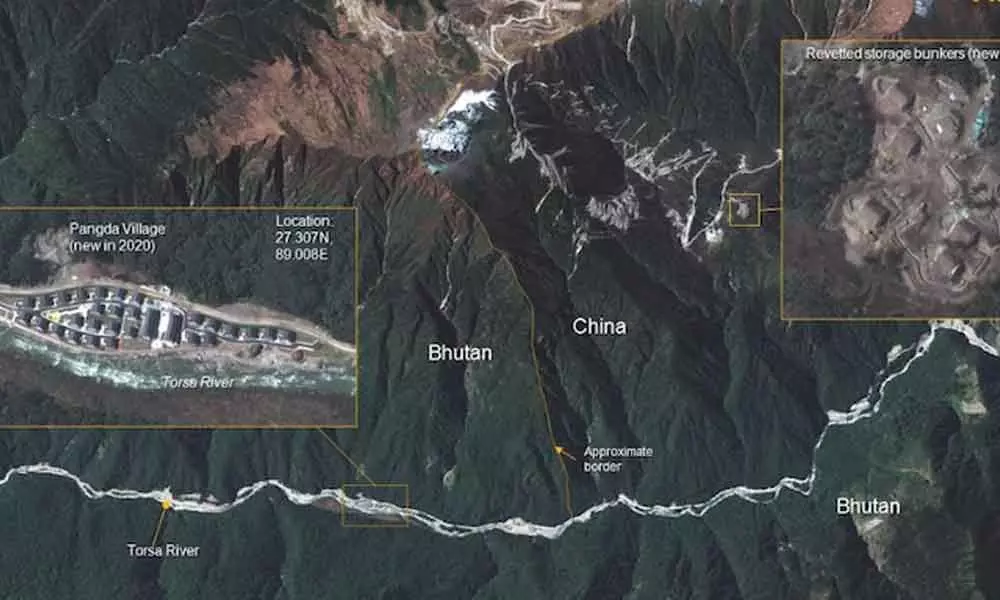Live
- Crime Rate in Rachakonda Increases by 4% in 2024, Cybercrimes Surge by 42.5%
- AIM, Niti Aayog’s Youth Co:Lab challenge 2025 to foster innovation for disabled
- IIT Delhi students receive job offers from US, UK, UAE, Japan in abundance
- Pushpa 2 Leads to the Capture of Notorious Gangster Vishal Meshram in Nagpur
- WhatsApp to End Support for Older Android Phones From January 1, 2025
- CM Stalin Slams BJP-Led Government Over Election Rules Amendment
- Necrophilia: Chhattisgarh HC Observes Loophole In Indian Penal Code
- Jaipur tanker blast: Vasundhara Raje meets kin of injured, follows medical protocol
- AAP-BJP Showdown Ahead Of Delhi Assembly Elections
- Can a woman make such allegations out of imagination: K'taka Minister
Just In
China turns villages near LAC into military infra


China turns villages near LAC into military infra
Satellite images show the so-called civilian dwellings are nothing but extension of cantonments with no population
New Delhi: Beautifully constructed homes, recreational facilities and roads, all disguised as civil infrastructure near the Line of Actual Control (LAC) on the Chinese side is part of the People's Liberation Army's new warfare tactics to enhance its military network.
These so-called civilian dwellings part of integrated model villages are nothing but an extension of cantonments with no population occupying these places close to the borders.
A set of seven new high-resolution satellite images, covering the Torsa river valley near the Bhutan-China border, puts on display the possible execution of this new Chinese warfare strategy, which China hopes to deploy all along its western borders. Images released on Sunday by space firm Maxar Technologies showed Chinese construction at a newly-built Pangda village in the valley. However, the real story of Chinese deception is not a remote village with less than three dozen residential structures, but what comes with it. It seems China has been adopting a policy of setting up dual-use integrated villages close to the borders that can be used as strategic military assets by the Chinese armed forces.
The images reviewed clearly show newly-built military storage bunkers and under-construction roads at the strategic locations on the other side of the village, revealing the actual use of such facilities in the border area.
The integrated villages are essentially an extension of cantonments, close to the border areas. The aim of these integrated model villages is to ensure the co-existence of the military and civilian population at the frontier areas of the Tibetan Autonomous Region that is sparsely populated, sources say. These are newly-developed villages meant for settling civilians but that's hardly happened.
Earlier, there were many reports of the existence of such facilities along the Line of Actual Control region months before the stand-off between the two sides began in May 2020. "Both the army and civilians can use it. The development also strengthens the claim over land in case of an escalation. They are extensions of military cantonments," an official said.
"If these were indeed meant for civilians, people would be residing here.
But these integrated villages largely remain unoccupied," said an official in the security establishment.
Usually, these villages also have reconnaissance towers. China has already set up over two dozen of such integrated villages across the LAC, including in the eastern sector opposite Arunachal Pradesh and Sikkim.
Some of the earlier established villages are well-connected by newly-made Chinese four-lane roads. India has also adopted a policy of opening some of the places near the LAC for tourists.
The new Chinese construction area, seen in the images about 9 kms to the east from the site of the 2017 India-Chinese stand-off in the Doklam plateau, has now established how China - in the guise of the setting of civilians villages - is actually enhancing its military establishments close to the borders.
But the construction of the village is not the only feature of these images. New military storage bunkers, set up on the tactical heights confirm what the Indian agencies have suspected for long.
China could be setting up a dual-use integrated village, designed to assist its military operations near the crucial Bhutan border.

© 2024 Hyderabad Media House Limited/The Hans India. All rights reserved. Powered by hocalwire.com






